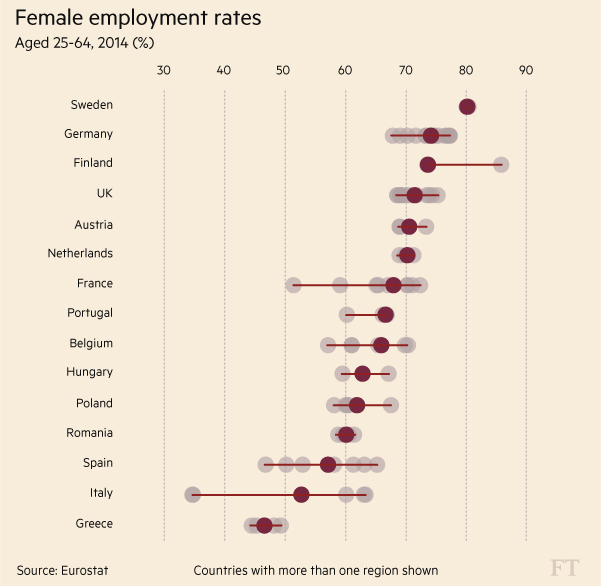Gender gaps in EU regions: worse in Southern Europe – and in London
About two in three women aged 25 to 64 years old are in employment in the European Union, the highest proportion since the data series began 23 years ago. However, the EU average conceals considerable variation between regions.
In some countries, including Sweden, Germany and the UK, female employment rates are fairly similar across regions- less than 10 percentage points variance – but the difference increases to about 20 percentage points in France and Spain and to a maximum of 30 percentage points in Italy.
Nearly nine in ten women are in employment in the Åland region of Finland compared to less than four in ten in the Italian South and its islands of Sicily and Sardinia.
“In Italy the female labour market is very polarized” comments Willem Adema, Senior Economist in the Social Policy Division at the OECD in an interview with the FT. “Women in high education stay in full time employment – part-time jobs are generally not available – while if you are unskilled it does not pay to be in formal employment, you would rather do something in the informal market.”
An EU parliament paper notes that the low female employment rate in Southern Italy, is connected to the fact that “in some parts of Southern Italy childcare services are nearly non-existent and women are over-represented in atypical and precarious jobs.”
This conforms to what has been defined the “Mediterranean model of the welfare state”, based on monetary transfers from the state to the households and the unpaid work of women, so that the family has traditionally been the main provider of social protection and care services for Italians.
The South of Italy and its islands also show the highest gender difference in employment rates. The other EU regions with a wide gender gap in employment rates are other regions in Italy or from Greece or the Eastern European countries.
With one very noticeable exception – London- far and away the region with the highest GDP per capita in the EU.
In London 69 per cent of women of prime working age women are in employment, lower than the national average of 71 per cent and much lower than the male rate of 86 per cent.
Wealth inequality is possibly part of the explanation, as a study from the Greater London Authority found that the largest employment gap was in the extremely wealthy borough of Kensington & Chelsea – where households do not necessarily need incomes from both partners.
The employment gender gap in London is particularly high among women aged 35 to 44 years old, an age when the majority would have young children. “I am not surprised” comments Dr. Adema “the labour market is more flexible in the UK and it’s easier to drop out and then come back, work part-time and increase or decrease the working hours”.
In the south of Europe the gap is highest among the older people. In the south of Italy around double the proportion of men aged 45 to 55 years old are in employment compared to women. “Particularly the female employment rate for the older age cohort (age 55-64) is in some cases strikingly low. (…)This may reflect the unavailability of care facilities for grand-children or dependent parents” affirms apaper of the European Commission.
The employment gender gap shrank after the crisis, but largely as a result of declining employment rates among men. Female employment rates started rising again in 2011 with an accelerating pace in 2014.
But not in every region. Throughout Greece, Bulgaria, Romania, Spain and the Netherlands – in general in all of the regions with the most dramatic fall in output following the financial crisis – female employment rates are still below 2007 levels, with the Athens region of Greece (Attiki) showing the worst change.
On the other hand female employment rates increased the most in Germany. Almost all of the regions with the highest increase in female employment rates since 2007 were in Germany. “Ten years ago or more companies looked down upon mothers of young children, now there is a much larger acceptance. Many German women are in part-time and mini jobs (up to 12 hours per week)” explains Dr. Adema. Over 37 per cent of women work part time in Germany- one of the highest proportions in the OECD-, compared to nine per cent of men.
The rising female employment rate in the EU is certainly good news, but the substantial divergence between regions shows there is still much progress to be made






No comments:
Post a Comment